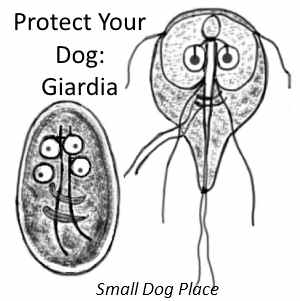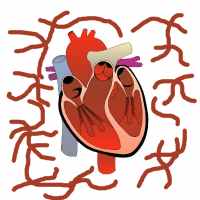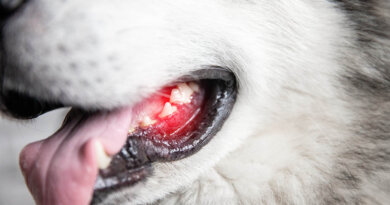Another Parasite You Should Know
By Janice Jones |Last Updated 11-22-2021
As parasites go, giardia in dogs is a particularly nasty bug that is not only difficult to get rid of but causes vomiting and diarrhea especially in young puppies
 Giardia in Dogs: Cyst and trophozoite life-stages
Giardia in Dogs: Cyst and trophozoite life-stagesWhat is this Parasite?
Giardia in dogs is another annoying parasite that can
affect your dog’s health. This small
protozoan, Giardia is not a worm, but a one-celled organism that is also
capable of causing harm in many animals including people, although it’s not
entirely clear how common the transmission is between dogs and people.
It is a very common parasite found in dogs,
cats, horses, pigs, cows, sheep, and goats. The resultant disease is called
giardiasis.
How Do I and my Dog Get this Parasite?
People get giardia when they sample contaminated
water usually on a camping trip and the resulting vomiting and diarrhea is
called traveler’s diarrhea.
If you are
an outdoors type of person, you might have heard of beaver fever or backpacker
disease. These are all caused by the
giardia organism.
In dogs, the
most common form of transmission is through the fecal—oral route where dogs
either come in contact with infected feces, water, or surfaces that contain the
giardia cysts. They can do this by eating the cysts directly, sniffing infected
poop and then licking their lips, or drinking contaminated water.
The infection is easy to pick up because the Giardia cysts
are very resilient and contagious immediately after another animal has excreted
them.
When there is high humidity, the
survival rate of the cysts increase and when there are more animals in the
area, infection is inevitable. This is why you see these infections in
shelter dogs, pet stores, and multiple dog homes.
Life Cycle of Giardia in Dogs
There is much that veterinarians do not know about
the life cycle of this one celled organism.
This protozoan appears to have a two stage life cycle.
To begin an infection, a dog ingests a cyst
usually through eating poop, infected grass or drinking contaminated
water. The cyst pasts through to the dog’s
small intestine where it opens up and releases an active version called a trophozoite.
During this stage, the tiny organism is motile
and lives in the small intestine of its host.
Here it attaches itself and dines on the cells lining the intestines. This causes poor digestion which leads to
diarrhea. This stage will reproduce by dividing and then many will produce hard
cysts around them.
These cysts are then
shed in the stool where they can infect another dog or other animal that comes
in contact with the infected feces. Once the second dog swallows the cyst, it
migrates to the small intestine and the process begins again.
This hardy cyst phase can exist in the environment
for up to several months, especially in water and damp locations.
Giardia in dogs is common, but also
occurs in farm animals and people. There
seems to be different groupings of these organisms called Assemblages that
affect different species of animals.
For
example, dogs tend to have assemblages C and D, cats are infected by A1 and F,
and humans are normally more susceptible to A2 and B.
This is good news for people since it is possible
to contract giardia from dogs, it is not likely, but again there is much to
learn about this parasite. When humans acquire this type of infection it is
usually as a result of coming in contact with contamination from human
waste.
This often occurs when giardia
enter the public water supply. Outbreaks
have known to happen even in day care centers where there is a breakdown in
good hygiene practices.
Symptoms of Giardiasis in Dogs
- Foul smelling feces
- Diarrhea with some mucus and/or blood
- Vomiting
- Sometimes Fever
- Loss of weight if not treated
If
your dog has foul smelling diarrhea, that can range from soft to watery with
traces of mucus he might have giardia. Sometimes blood is seen in the stool.
Vomiting is another symptom and sometimes fever. If symptoms persist, the dog may also lose
weight. Often dogs that are infected
with giardia show no symptoms at all.
Luckily,
this is not a life threatening disorder unless the dog has other underlying
problems that might cause him to be immunocompromised.
Diagnosis
of Giardia in Dogs
You
will not be able to diagnosis this yourself as the parasite is microscopic and
only detected through laboratory tests that are performed by a veterinary
hospital or outside laboratory. Giardia is often misdiagnosed or underdiagnosed
because it is difficult to see.
There
are several ways to observe the cysts, but since cysts are not shed continually,
it is very possible to receive several negative test results, but still have
the disease.
There are several tests
that are often used including a direct smear using a fresh, unrefrigerated
sample, fecal flotation, and a fecal ELISA called the Snap® Test.
If
a fresh sample is observed under the microscope, the more active form or
trophozoite can sometimes be observed moving around. When a fecal flotation method is done, the
vet tech is looking for the cyst stage.
Unfortunately,
both positive and negative results can be confusing. Many dogs many shed the cysts without having
any symptoms, whereas some who have symptoms and the disease may not shed any
cysts on the day of the test.
Some veterinarians
will repeat a test that has negative results when the dog shows the classic
symptoms.
Drug Treatment for Giardia in Dogs
Here is another area of controversy in the
veterinary profession: How and when to
treat? Some vets will treat even with a
negative test result if the dog is showing other signs of the disease because
there is a potential for human infection.
There are several drugs on the market that will
treat the infection but all require multiple days to administrate the
medications.
Metronidazol or Flagyl
Metronidazole is an antibiotic which is given for 5
to 7 days. Going by the trade name,
Flagyl, this older treatment is about 60-70 effective for the treatment of
giardia, but will treat other bacterial causes of diarrhea. Side effects of this drug include vomiting,
anorexia, and liver toxicity. It cannot
be given to pregnant dogs.
Fenbendazole or Panacur
Fenbendazole, or Panacur, is a worming medicine or antiparasitic
that also treats other types of parasites and is given for 5 days to treat
giardia. This is considered to be safe in young puppies at least 6 weeks old.
Sometimes, a combination of metronidazole and
fenbendazole are given.
Environmental Treatment of Giardia in
Dogs
Bathing is also required as the dog is
being treated to remove any fecal debris and eliminate any cysts that might
remain on the dog’s hair or fur. When
there are other dogs in the household, they all may be treated at the same
time. A regular dog shampoo is usually
sufficient to remove all fecal debris.
It is difficult to decontaminate soil,
grass or remove standing water in the outdoor area. Cysts will not survive in dry conditions, but
prompt removal of any feces will help eliminate the problem, at least in areas
where there is not much rainfall. In
moist or wet areas, it is nearly impossible to remove the threat entirely, but
quick removal of the dog’s poop will help.
Inside, any surfaces the dog comes in
contact with can be cleaned and sanitized using steam cleaning or
disinfectants.
For disinfecting
surfaces, such as floors or crates, you can use chlorine bleach at a rate of
1-2 cups per gallon of water.
Other
chemicals such as quartenary ammonium or Lysol work well to kill the
cysts. Clean, disinfect, and allow to air
dry before allowing your dog to have access to the area.
The longer the
disinfectant stays on the surface the better the chances that all cysts will be
killed. Ten minutes is usually a good
ball park figure to aim for if you are spray with a bleach solution.
Public Health Concerns of Giardia in Dog
This is still another area of
controversy. To be on the safe side, you
should consider the possibility that the giardia that infects dog could
potentially infect people.
Most sources,
however, suggest that Infection is low between dogs and humans. People who have diseases that might increase
their susceptibility to infection should limit their exposure to dogs being
treated for giardia. We are including
people in this category that are immunodeficient such as those with AIDS or
cancer, or those who are undergoing chemotherapy.
If you do develop gastrointestinal symptoms
after being exposed to an infected dog, it would be advisable to seek medical
attention.
Always wash your hands before and after
feeding and handling the dog and of course after cleaning up soiled areas.
If you have children, encourage children to
get into the habit of washing their hands regularly especially after playing
with their dog.
References and Further Reading on
Giardia in dogs
Centers for Disease Control and
Prevention
Other Types of Parasites in Dogs
 Dog Heartworms
Dog Heartworms
Does This Article Deserve Your Thumbs Up?
We always appreciate your support and encouragement. Your thumbs up means so much to us. Please like this article.
If you find this page or any page on Small Dog Place Helpful, or Useful in anyway, I’d love it if you would click the small heart found on the bottom right of each page.
You can also share or bookmark this page — just click on the:

Free Monthly Newsletter
Sign Up for Our Free Newsletter and get our Free Gift to You.
my E-book, The Top 10 Mistakes People Make When Choosing a Dog (and how to avoid them)




